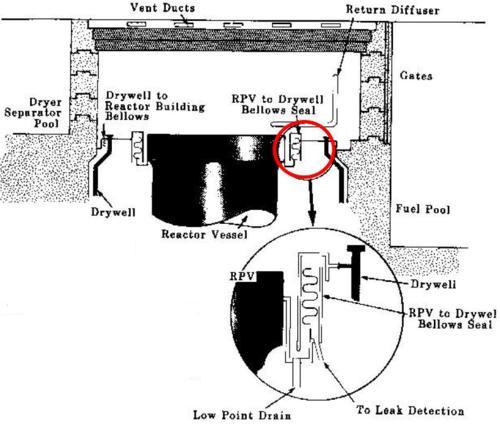
On August 21, 1984, workers at the Haddam Neck plant in Connecticut prepared to remove equipment from the reactor vessel. The reactor had been shut down for a refueling outage a few days earlier. Workers filled the reactor cavity with water and removed the reactor vessel head.
The reactor cavity is a large space above the reactor vessel that is dry during normal reactor operation. It is flooded with water during refueling outages to allow irradiated fuel assemblies and contaminated equipment to be moved from the reactor vessel to the spent fuel pool under the protective shielding afforded by the water.
The gap between the reactor vessel and the floor of the reactor cavity (comparable to the “RPV to Drywell Bellows Seal” area shown in the figure, even though this figure is for a boiling water reactor and Haddam Neck was a pressurized water reactor) is filled during plant operation by the reactor vessel head and shielding material. During refueling outages, this gap is filled by a seal ring.
The original seal design was modified because it leaked excessively. The replacement seal ring featured two large rubber air tubes similar to bicycle tire inner tubes. This arrangement was being used at the Haddam Neck plant for the first time during the 1984 refueling outage.
The new-fangled contraption backfired. Water pressure pushed part of the outer air tube through the gap between the reactor vessel wall and the reactor cavity floor – the very gap it was supposed to seal. The unsealed gap allowed 200,000 gallons of water to flow from the reactor cavity into the containment building in only 22 minutes. The containment building floor flooded to a depth of 18 inches.
Fortunately, the transfer tube between the reactor cavity and the spent fuel pool was closed at the time of the seal failure. Had it been open, as it would have been when fuel assemblies were being moved, the water in the spent fuel pool would also have drained. The spent fuel pool water level would have dropped to about three feet below the top of irradiated fuel assemblies in the storage racks. The uncovered irradiated fuel may have overheated, causing blistering and cracking of the fuel rods.
If an irradiated fuel assembly had been lifted out of the reactor vessel when this happened, the loss of water from the reactor cavity would have completely uncovered it. The plant’s owner calculated that the radiation dose rate to workers on the refueling platform from an exposed fuel assembly would have been about 50,000 rem per hour. Considering that 450 to 600 rem can be a lethal dose, workers would have had about 30 seconds to evacuate the area if they were to survive.
The plant’s owner also evaluated its Millstone Units 1, 2, and 3 plants for this type of reactor cavity seal failure. They determined that the Millstone Unit 1 spent fuel pool water level would drop to 20 inches above the irradiated fuel assemblies in 11 minutes with the resulting radiation fields estimated to be 2,400,000 rem per hour at the spent fuel pool railing (in line of sight of the source) and 65 rem per hour in the working area around the pool.
On Millstone Unit 2, the spent fuel pool water level would drop to 12 inches above the irradiated fuel assemblies in 80 minutes with the resulting radiation fields estimated to be 4,000,000 rem per hour at the pool railing and 54 rem per hour on the refueling floor. On Millstone Unit 3, the spent fuel pool water level would drop to 31 inches above the irradiated fuel assemblies in 120 minutes with the resulting radiation fields estimated to be 1,900,000 rem per hour at the pool railing and 37 rem per hour on the refueling floor.
To put these radiation fields in perspective, a worker exposed to 37 rem per hour receives the maximum annual radiation dose permitted by federal law in about 49 seconds, while a worker exposed to 1.9 million rem per hour receives a fatal radiation dose in about a second.
After this Haddam Neck event, the NRC required all plant owners to determine if their facilities were potentially vulnerable. Many owners calculated consequences as serious as those reported above for Millstone. The NRC accepted these severe consequences because they considered the chances of such a catastrophic seal failure to be extremely remote.
The seal failure at Haddam Neck was also considered unlikely. At least, that is, until it happened.
Our Takeaway
Even though they happen fairly often, events that drain water from the spent fuel pool and refueling cavities are considered incredible by the NRC. Not incredible as in “that’s awesome, dude,” but incredible as in not credible or “ain’t happening, dude.” Consequently, such events and the design features and administrative controls intended to prevent them from occurring or mitigate them should they occur are not covered in the plants’ Updated Final Safety Analysis Reports (UFSARs).
What does it matter? A federal regulation (10 CFR 50.59) requires plant owners to formally evaluate proposed changes to their facilities and procedures to determine if safety margins previously approved by the NRC may be eroded. If so, prior NRC permission is required before the proposed change can be implemented. These mandated evaluations answer questions like “will the proposed change increase the likelihood of a previously analyzed event?” and “will the proposed change increase the consequences from a previously analyzed event?” Because spent fuel pool draindown events are missing from the UFSARs, modifications to plants and revisions to procedures are made without the full evaluations that are supposed to prevent safety margin erosion.
The simplest way to overlook a problem is not to look.
“Fission Stories” is a weekly feature by Dave Lochbaum. For more information on nuclear power safety, see the nuclear safety section of UCS’s website and our interactive map, the Nuclear Power Information Tracker.
